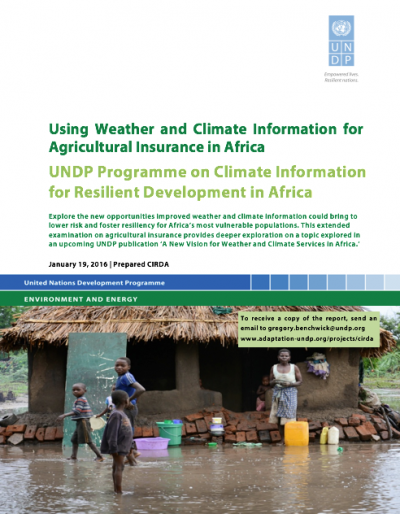Using Weather and Climate Information for Agricultural Insurance in Africa

Lowering risk and building resiliency is an essential component of sustainable development. It constitutes a huge win for both the public and private sectors, with increased productivity and market stealth, improved risk thresholds for smallholder farmers, and the potential for greater market stability.
Many of the least developed countries in the world are rural and the majority of the population rely on agriculture as a form of livelihood. Farmers face a slew of risks, from market and financials to weather, disease and pest issues. Most of the risk and impact faced by farmers is weather related. Fluctuations in temperature, severity and frequency of storms, or rainfall can impact the crop yield dramatically, which threatens the household welfare and ultimately threatens local food security and political stability on the national level.
Statistics from the International Disaster Database over the last 30 years indicate that an estimated 1,000 natural disasters took place in Africa affecting 328 million people with damages estimated at $24 trillion. Although floods have accounted for most of the total disasters, droughts are the hazard that has affected the most people and caused the most damage, accounting for 80% of people affected and 40% of total economic damages. These weather shocks can have serious consequences for smallholder livelihoods, particularly when they are uninsured.
The traditional financial tools available to small-scale rural farmers are often non-existent or unaffordable, or if provided by the state, these instruments will be focused on recovery. As a result of this uncertainty, farmers tend to fall back to traditional methods of risk management, which includes saving money and planting lower-quality crops. Because weather shocks are so consequential, the mere possibility of low rainfall can make farmers reluctant to invest in risky-but-profitable activities and technologies, further lowering their future earnings. Lack of insurance deters smallholder farmers from seeking loans for fear of being unable to pay back the loans and losing productive assets, which were secured as collateral. This paradigm of risk aversion continues to agricultural inputs such as fertilizer, better quality seed and agricultural technology. In some extremes, domestic households are known to keep children from school in order to utilize their services in the field. Inadequate or unaffordable risk management facilities or instruments amplify the impacts of weather-related shocks, which result in far reaching implications on national and regional stability.
In this issues brief, explore the new opportunities improved weather and climate information could bring to lower risk and foster resiliency for Africa’s most vulnerable populations. This extended examination on agricultural insurance provides deeper exploration on a topic discussed in an upcoming UNDP publication ‘A New Vision for Weather and Climate Services in Africa.’